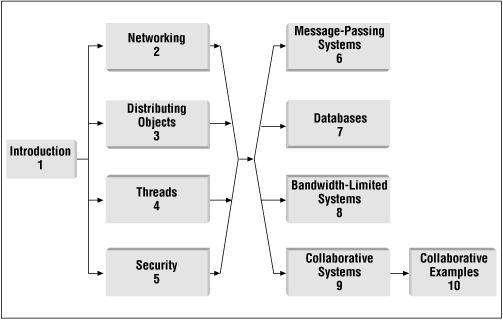What Does This Book Cover?
This book is an overview of the tools and techniques that are at your disposal for building distributed computing systems in Java. In most cases, these tools are provided inherently in the Java API itself, such as the Java Remote Method Invocation (RMI) API, the Java Security API, and the Java™ Database Connectivity ( JDBC) package. Other tools are standards and protocols that exist independently of Java and its environment, but are supported within Java, either through its core APIs or by add-on APIs offered by third-party vendors. Some examples include the Common Object Request Broker Adapter (CORBA) standards, the multicast IP protocol, and the Secure Socket Layer (SSL) standard.
I intend this book to serve as both explanatory and reference material for you, the professional developer. Most of the book is made up of detailed explanations of concepts, tools, and techniques that come into play in most distributed computing situations. At the same time, for readers who are more familiar with the subject matter, the text and code examples are broken up into subject areas that should make it fairly easy to reference important bits.
Organization
The first four chapters of the book (after the Introduction) cover some fundamental tools that come into play in most distributed applications: basic networking tools, distributed objects, multithreading, and security measures. The last five chapters go into detail about some common types of distributed applications: message-passing systems, multitier systems involving databases, bandwidth-limited systems, and systems that allow multiple distributed users or user agents to collaborate dynamically over a network; and discuss the special issues that arise in each.
The figure on the next page shows the dependence of the various chapters on each other, to give you a sense of the order (random or otherwise) that you can choose as you journey through the book. Since the Introduction covers some concepts and terminology that will persist throughout the book, I’d suggest reading it before any of the others. The next four chapters can be read in just about any order, depending on your level of experience with each topic. Since the later chapters use concepts from all of the chapters in the first part of the book, you should have a basic understanding of their topics, either from personal experience or from reading the earlier chapters, before delving into the second part of the book.
Get Java Distributed Computing now with the O’Reilly learning platform.
O’Reilly members experience books, live events, courses curated by job role, and more from O’Reilly and nearly 200 top publishers.


